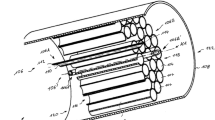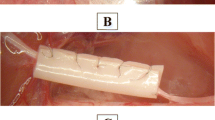Abstract
Despite the presence of various nerve coaptation materials and techniques, achievement of the functional nerve regeneration is still inadequate. This study was aimed to compare the effectiveness of conduit composed of collagen biomatrix and omentum graft on peripheral nerve regeneration. Thirty-five male Wistar rats were divided into four groups. In the control group, the right sciatic nerve was skeletonized from the sciatic notch till the point of bifurcation. In the primary epineural repair group, the nerve was transected 1 cm proximal to the bifurcation with a sharp pair of micro scissors and then repaired with four epineural sutures. In the collagen biomatrix group, the epineural repaired nerve was wrapped with collagen biomatrix. In the collagen group, the epineural repaired nerve was wrapped with the nonpediculated omentum. Assessment of the nerve regeneration was based on functional (Walking Track Analysis, Electrophysiological Measurements), histological, and morphometric criteria. Light and electron microscopic examinations showed that collagen-biomatrix-wrapped specimens have the best regeneration. The electrophysiological study confirmed the recovery of electrical activity in the regenerated axons.



Similar content being viewed by others
References
Agner C, Yeomans D, Dujovny M (2001) The neurochemical basis for the applications of the greater omentum in neurosurgery. Neurol Res 23(1):7–15
Ahmed MR, Venkateshwarlu U, Jayakumar R (2004) Multilayered peptide incorporated collagen tubules for peripheral nerve repair. Biomaterials 25(13):2585–2594
Bain JR, Mackinnon SE, Hunter DA (1989) Functional evaluation of complete sciatic peroneal and posterior tibial nerve lesions in the rat. Plast Reconstr Surg 83:129–138
Chiu DT, Janecka I, Krizek TJ, Wolff M, Lovelace RE (1982) Autogenous vein graft as a conduit for nerve regeneration. Surgery 91(2):226–233
Cruz NL, Debs N, Fiol RE (1986) Evaluation of fibrin glue in rat sciatic nerve repairs. Plast Reconstr Surg 78:369–373
de la Torre JC, Goldsmith HS (1990) Collagen-omental graft in experimental spinal cord transection. Acta Neurochir (Wien) 102(3–4):152–163
de la Torre JC, Goldsmith HS (1988) Increased blood flow enhances axon regeneration after spinal transection. Neurosci Lett 94(3):269–273
De Medinaceli L (1988) Functional consequences of experimental nerve lesions: effects of reinnervation blend. Exp Neurol 100(1):166–178
De Medinaceli L (1990) Use of sciatic function index and walking track assessment. Microsurgery 11(2):191–192
Dubey N, Letourneau PC, Tranquillo RT (1999) Guided neurite elongation and Schwann cell invasion into magnetically aligned collagen in simulated peripheral nerve regeneration. Exp Neurol 158(2):338–350
Fawcett JW, Keynes RJ (1986) Muscle basal lamina: a new graft material for peripheral nerve repair. J Neurosurg 65(3):354–363
Garcia-Gomez I, Goldsmith HS, Angulo J, Prados A, Lopez-Hervas P, Cuevas B, Dujovny M, Cuevas P (2005) Angiogenic capacity of human omental stem cells. Neurol Res 27(8):807–811
Glasby MA, Gschmeissner SG, Hitchcock RJI, Huang CL-H, de Souza BA (1986) A comparison of nerve regeneration through nerve and muscle grafts in rat sciatic nerve. Neuroorthopaedics 2:21–28
Goldsmith HS, Fonseca A Jr, Porter J (2005) Spinal cord separation: MRI evidence of healing after omentum-collagen reconstruction. Neurol Res 27(2):115–123
Happak W, Neumayer C, Holak G, Kuzbari R, Burggasser G, Gruber H (2000) Morphometric and functional results after CO(2) laser welding of nevre coaptations. Lasers Surg Med 27(1):66–72
Hare GM, Evans PJ, Mackinnon SE, Best TJ, Bain JR, Szalai JP, Hunter DA (1992) Walking track analysis: a long-term assessment of peripheral nerve recovery. Plast Reconstr Surg 89(2):251–258
Kong JM, Zhong SZ, Bo S, Zhu SX (1986) Experimental study of bridging the peripheral nerve gap with skeletal muscle. Microsurgery 7:183–189
Ludborg G, Hasson HA (1980) Nerve regeneration through performed pseudosynovial tubes. A preliminary report of a new experimental model for studying the regeneration and reorganization capacity of peripheral nerve tissue. J Hand Surg 5:35–38
Lundborg G, Kanje M (1996) Bioartificial nerve grafts: a prototype. Scand J Plast Reconstr Surg Hand Surg 30:105–110
Mackinnon SE, Dellon AL, Hudson AR, Hunter DA (1985) Nerve regeneration through a pseudosynovial sheath in a primate model. Plast Reconstr Surg 75(6):833–841
Mackinnon SE, Dellon AL, O'Brien JP (1991) Changes in nerve fiber numbers distal to a nerve repair in the rat sciatic nerve model. Muscle Nerve 14(11):1116–1122
Meek MF, Dijkstra JR, Den Dunnen WFA, Ijkema-Paassen J, Schakenraad JM, Gramsbergen A, Robinson PH (1999) Functional assessment of sciatic nerve reconstruction: biodegradable poly (DLLA-e-CL) nerve guides versus autologous nerve grafts. Microsurgery 19:381–388
Navarro X, Rodriguez FJ, Labrador RO, Buti M, Ceballos D, Gomez N, Cuadras J, Perego G (1996) Peripheral nerve regeneration through bioresorbable and durable nerve guides. J Peripher Nerv Syst 1:53–64
Nicoli-Aldini N, Perego G, Cella GD, Maltarello MC, Rocca M, Giardino R (1996) Effectiveness of a bioabsorbable conduit in the repair of peripheral nerves. Biomaterials 17:959–962
Ochi M, Osedo M, Ikuta Y (1995) Superior nerve anastomosis using a low-output CO2 laser on fibrin membrane. Lasers Surg Med 17(1):64–73
Odaka M, Uchiyama Y, Oka Y, Tamaki T (2003) Evaluation of morphological and functional regeneration of rat nerve-muscle units after temporary and permanent tubulization. Muscle Nerve 28(2):194–203
Ozkan O, Safak T, Vargel I, Demirci M, Erdem S, Erk Y (2002) Reinnervation of denervated muscle in a split-nerve transfer model. Ann Plast Surg 49(5):532–540
Risitano G, Cavallaro G, Lentini M (1989) Autogenous vein and nerve grafts: a comparative study of nerve regeneration in the rat. J Hand Surg 14(1):102–104
Salonen V, Röyttä M, Peltonen J (1987) The effects of nerve transection on the endoneurial collagen fibril sheaths. Acta Neuropathol 74(1):13–21
Smahel J, Meyer VE, Bachem U (1987) Gluing of peripheral nerves with fibrin: experimental studies. J Reconstr Microsurg 3:211–220
Takahashi M, Satou T, Hashimoto S (1988) Experimental in vivo regeneration of peripheral nerve axons and perineurium guided by resorbable collagen film. Acta Pathol Jpn 38:1489–1502
Valero-Cabre A, Tsironis K, Skouras E, Perego G, Navarro X, Neiss WF (2001) Superior muscle reinnervation after autologous nevre graft or poly-l-lactide-epsilon-caprolactone (PLC) tube implantation in comparison to silicone tube repair. J Neurosci Res 63:214–223
Ventura R, Torri G, Campari A, Giandomenico A, Peretti G (1980) Experimental suture of the peripheral nerves with "fibrin glue". Ital J Orthop Traumatol 6(3):407–414
Weber RA, Breidenbach WC, Brown RE, Jabaley ME, Mass DP (2000) A randomized prospective study of polyglycolic acid conduits for digital nerve reconstruction in humans. Plast Reconstr Surg 106:1036–1045
Williams LR, Longo FM, Powell HC, Lundborg G, Varon S (1983) Spatial-temporal progress of peripheral nerve regeneration within a silicone chamber: parameters for a bioassay. J Comp Neurol 218:460–470
Yannas IV, Hill BJ (2004) Selection of biomaterials for peripheral nerve regeneration using data from the nerve chamber model. Biomaterials 25:1593–1600
Young RC, Wiberg M, Terenghi G (2002) Poly-3-hydroxybutyrate (PHB): a resorbable conduit for long-gap repair in peripheral nerves. Br J Plast Surg 55:235–240
Author information
Authors and Affiliations
Corresponding author
Additional information
Comments
Ugur Türe, Istanbul, Turkey
The authors have provided a clear and concise experimental study that assessed peripheral nerve regeneration in Wistar rats. The authors transected the sciatic nerve and compared the effectiveness of a conduit composed of a collagen biomatrix and omentum graft on peripheral nerve regeneration. They made a functional assessment of the regeneration with the Walking Track Analysis and electrophysiological measurements. The authors have supported their findings with a histological assessment and electron microscopy.
A comparison of the thickness of myelin between the test groups showed that the collagen biomatrix group had greater scores, and the nerve velocity values of this group were also greater. The authors noted that the collagen biomatrix minimizes the foreign-body reaction and provides a properly aligned matrix scaffold that allows regular Schwann cell proliferation and blocks fewer axons.
Interesting findings of the study are the results of the Omentum Group. The results in this group were even worse than those of patients undergoing primary epineural repair. These findings are not in accordance with the regeneration-activating character of the omentum. The authors associate this worse alignment with a poorer quality of nourishment of the omentum cells. Another interesting finding is the average number of myelinated fibers. In all groups, this number is higher than in the control group. The authors believe this result is from multiple aberrant axonal sprouting from the proximal nerve fiber and that the regenerated nerve fibers had not matured completely in the regenerated segment by a 12-week period.
The results of this study have implications for neurosurgeons who perform peripheral nerve surgery. The take-home message is that the biological and mechanical structure of the graft material is very important in achieving an effective nerve regeneration and the collagen biomatrix may really support nerve regeneration. We may have further information to contribute. Dubey et al. (1) noted that, in repairing transected nerves, a solution could be to find bioresorbable collagen nerve guides with magnetically aligned collagen gel implanted in the surgical gaps. This procedure might stimulate the correct orientation and fasten both the speed and functional success of the regeneration.
Reference
1. Dubey N, Letourneau PC, Tranquillo RT. Guided neurite elongation and Schwann cell invasion into magnetically aligned collagen in simulated peripheral nerve regeneration. Exp Neurol. 1999 Aug;158(2):338-50.
Rights and permissions
About this article
Cite this article
Cemil, B., Ture, D., Cevirgen, B. et al. Comparison of collagen biomatrix and omentum effectiveness on peripheral nerve regeneration. Neurosurg Rev 32, 355–362 (2009). https://doi.org/10.1007/s10143-009-0193-5
Received:
Revised:
Accepted:
Published:
Issue Date:
DOI: https://doi.org/10.1007/s10143-009-0193-5




